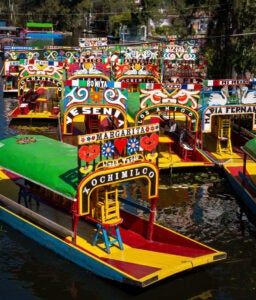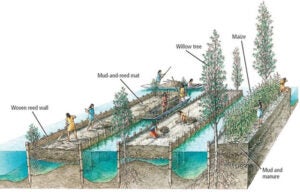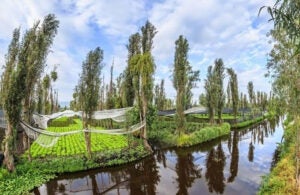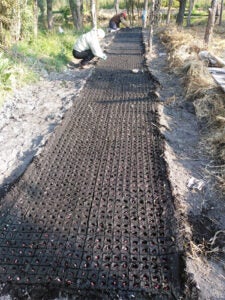MEXICO CITY — The capital of Mexico, with a population of 22 million, is the biggest city in North America. As you fly into the city the enormity of the urban landscape becomes evident. The neighborhoods stretch endlessly, and upon arrival you are greeted by an overwhelming amount of traffic, smog, and the ceaseless activity of a city that never rests.
Despite the urban chaos, Mexico City manages to preserve one of the area’s oldest farming traditions. In the borough of Xochimilco, farmers are using ancient techniques to produce some of the highest-quality foods in the city, yet these techniques are becoming endangered.
Xochimilco is a former lake that transformed into canals over the years. The reason for this transformation can be attributed to chinampas, which are essentially floating islands. It’s here that some of the most nutritionally dense foods are being produced using ancient sustainable Aztec farming methods.

Chinampas are small, rectangular, artificial islands built for farming on the lake. The word “chinampa” translates to “in the fence of reeds” in nahual, the native language of the Aztecs. When the Spanish conquered Tenochtitlan (present day Mexico City), which was an Aztec city founded around 1325 C.E., much of it was destroyed or repurposed to create churches and the city structure that we see today.
Tenochtilan was founded on lake Texcoco, which was one of five shallow lakes in the basin, after the Aztecs left their land of Aztlan. Historians hypothesize that Aztlan may have been situated in the northwestern regions of Mexico or the southwestern territories of the United States. They set out in the direction of Huizilopochtli, the god of sun and war, who told them to establish a city wherever they spotted an eagle perched on a cactus, devouring a serpent – the very image on the Mexican flag.
Because of this, the city lies in a giant basin about 7,500 feet above sea level. Due to the unique geography of the area, there is no outlet for the sediment and organic material that washes down from the surrounding mountains, which settled at the bottom of these lakes. This has been the case for millenia, which has left the lakes full of fertile materials that were used to build the chinampas.
Nearly 500 years later, amid the modern metropolis, the legacy of the Aztec civilization continues in Xochimilco where the traditional farming methods of utilizing chinampas still exist.
This region is unique as it remains one of the first indigenous sustainable agriculture systems in the world dating back 1100 C.E.
Joahna Herenandez, senior director of marketing for Arca Tierra, says, “Currently we combine ancestral chinampera agriculture techniques with organic, biointensive, permaculture, and agroforestry techniques. These contemporary practices help restore soils and keep them alive and healthy through crop rotation, establishment of consortia, soil coverage with organic matter, use of biological fertilizers, never herbicides or anything that is foreign to nature. We follow practices that help harvest the sun and plant water.
“Chinampas also provide ecosystem services, particularly greenhouse gas sequestration and biodiversity diversification, and they offer high recreational potential.”

The Aztecs came up with an ingenious way to build these islands for agricultural use. They started off with willow trees that were transplanted to the border of the island. Next to these willows were wooden reed walls that made a perimeter and formed the rectangular shape of the chinampa.
Once the reeds and willow trees were in place, the area was filled with aquatic plants and shrubbery. Placed atop these plants was nutrient and mineral dense mud scavenged from the bottom of the lake. The process of plants, shrubs, and mud was repeated until the desired height of the island was achieved.
Due to the expansion of the city and lack of proper water management, the chinampas are in danger of disappearing . Hectarage of chinampas has reduced drastically from over 100,000 to just 2,200.
One company that’s taken an interest in preserving the chinampas and their ancient cultivation techniques is Arca Tierra.
Lucio Usobiaga, cofounder of Arca Tierra, has dedicated himself to preserving regenerative farming techniques in the chinampas. He describes the chinampas as a former “food paradise.”
“You plant on land, you can fish and you can also hunt,” she said.
Due to its history and geography, the chinampa soils have about 11 percent organic matter. Organic matter consists of plant or animal tissue that are in various stages of decomposition. By comparison, most of the productive agricultural soils in the U.S. have between 3 percent and 6 percent organic matter, according to Cornell University.
“Arca Tierra is a network of professionals committed to the sustainable production of fresh, delicious and healthy food to take them from farm to table,” said Hernadez. “For the last 13 years, Arca Tierra has focused on promoting the sustainability and replicability of agriculture in productive, social, ecological and economic terms.”

Many of the vegetables grown here are used by some of Mexico City’s most famous chefs: Enrique Olvera (Pujol), Elena Reygadas (Rosetta), Jair Tellez (Merotoro), Gabriela Cámara (Contramar), Eduardo García, (Máximo Bistrot), Mercedes Bernal (Meroma) and Norma Listman (Masala y Maíz).
Some of the most valuable ingredients of these ancestral farming methods are found at the bottom of the lake in the form of mud. One method used by the farmers who work with Arca Tierra uses this mud to create a “chapin,” which helps to germinate seeds for transplanting.
The runoff from the rain ends up at the bottom of the lake, bringing with it minerals and organic matter. The farmers, who are known as chinamperos, know how to use this to their advantage, Hernandez said.
“The mud is not only used during the construction of the chinampa but throughout the growth period of the plants and also to germinate the seeds,” she said.
For the process of seeding and germination, the chinamperos follow these steps:
- A rectangle is excavated in the ground in the chinampa with a depth of approximately 20 centimeters.
- Mud is extracted from the depth of the channels and poured into the rectangle forming a seedbed.
- The seedbed is left to dry for a day so that the mud can be cut into small squares called chapines. Chapines, thanks to their mineral and nutritional content, give the seed all the ingredients it needs to germinate and develop.
- On each chapín, farmers will use their index finger in the center, pressing to form a small hole.
- On each hole of each chapín seeds are placed for germination.
- The seeds take two to four weeks to germinate, depending on their species.
- After three weeks to a month, the chapines, with their seedlings, are transplanted to the growing beds that must be ready with their compost and fertilizer to help the plant grow vigorously.

The historical importance of the chinampas in Xochimilco highlights the effectiveness of ancient sustainable agricultural practices.
“Chinampas are a human creation and are an endless source of inspiration,’ Hernandez said. “They represent a model that clearly shows us how we can energize and participate in natural processes to bring life to its best — and greatest — expression. And if that were not enough, the chinampas, fully worked, can provide the inhabitants of Mexico City with their vegetable consumption.”
Hernandez’s words may seem like a stretch for a city with 22 million inhabitants, but her statement is substantiated by University of Berkeley professor Miguel A. Altieri and Parviz Koohafkan, who is the director of Rural Development Division Sustainable Development Department, in Rome.
In a paper titled, Globally Important Ingenious Agricultural Heritage Systems, they state that the chinampas are, “one of the most intensive and productive production systems ever developed, and it is highly sustainable.”
Regenerative farming practices like chinampas, when managed effectively, yield significant returns with minimal resource inputs. These methods not only boost productivity but also provide vital ecosystem services such as greenhouse gas sequestration and the promotion of agrobiodiversity.
In a time of remarkable technological and scientific progress, ancestral knowledge can still offer valuable insights on how to feed entire cities like Mexico City, while minimizing inputs and other environmental factors.
David Salazar serves as the 2024 American Farmland Trust Agriculture Communications Intern at AGDAILY, with a focus on helping to amplify diversity and minority voices in agriculture. David is originally from King City, California, and attended the University of California, Fresno, as a first-generation college student. He received a bachelor’s degree in viticulture and enology and has worked in California’s premier wine producing regions.




